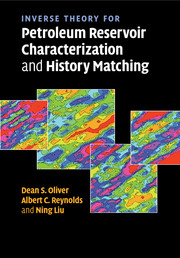Book contents
- Frontmatter
- Contents
- Preface
- 1 Introduction
- 2 Examples of inverse problems
- 3 Estimation for linear inverse problems
- 4 Probability and estimation
- 5 Descriptive geostatistics
- 6 Data
- 7 The maximum a posteriori estimate
- 8 Optimization for nonlinear problems using sensitivities
- 9 Sensitivity coefficients
- 10 Quantifying uncertainty
- 11 Recursive methods
- References
- Index
4 - Probability and estimation
Published online by Cambridge University Press: 06 January 2010
- Frontmatter
- Contents
- Preface
- 1 Introduction
- 2 Examples of inverse problems
- 3 Estimation for linear inverse problems
- 4 Probability and estimation
- 5 Descriptive geostatistics
- 6 Data
- 7 The maximum a posteriori estimate
- 8 Optimization for nonlinear problems using sensitivities
- 9 Sensitivity coefficients
- 10 Quantifying uncertainty
- 11 Recursive methods
- References
- Index
Summary
In this book we will consider several methods of generating solutions to the problem of estimating reservoir properties. Some solutions will honor the data exactly. Some solutions will be chosen because they possess special properties such as smoothness. Some solutions might be spatially discontinuous. We will find that some of the estimates of reservoir properties are not acceptable because they do not fit our preconceived notion of what the truth should be like. (This will be especially true when we use synthetic examples, in which case we know what the truth is supposed to look like.)
We require a way of representing our belief that some of the solutions are more likely to be correct than others, (1) either because they match the data better or (2) because they fit our notion of plausibility.
“Subjective probability” can be used to quantify the plausibility of models, and to represent our state knowledge. In Bayesian statistics, which is the philosophy we adopt, probability is used as a measure of uncertainty. It is legitimate, in this context, to assign probabilities to events that are not truly random. For example, we might assign a probability to the statement that Paris, France is further north than Montreal, Canada.
- Type
- Chapter
- Information
- Publisher: Cambridge University PressPrint publication year: 2008

